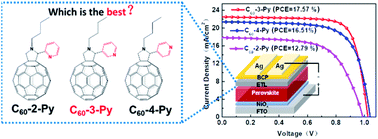Steering the electron transport properties of pyridine-functionalized fullerene derivatives in inverted perovskite solar cells: the nitrogen site matters†
Abstract
Fullerene derivatives with strong electron-accepting abilities have been extensively used as electron transport layers (ETLs) of inverted (p–i–n) planar heterojunction perovskite solar cells (iPSCs); however the effect of a specific heteroatom site within the fullerene derivative on its electron transport properties has scarcely been studied. Herein, by employing pyridinecarboxaldehydes bearing different nitrogen sites within the pyridine moiety as a reactant, three novel pyridine-functionalized fullerene derivatives with variable nitrogen sites (abbreviated as C60-n-Py, where n is the relative position of pyridine nitrogen with the site of pyridine moieties linked to the pyrrolidine ring of fullerene derivatives, n = 2, 3, 4) were synthesized facilely via a one-step 1,3-dipolar cycloaddition reaction, and their molecular structures as well as molecular packing were unambiguously determined by X-ray single crystal diffraction. Despite that C60-n-Py (n = 2, 3, 4) exhibit negligible difference in the molecular energy level and optical absorption, when using C60-n-Py as a novel ETL in CH3NH3PbI3 (MAPbI3) iPSC devices, their electron transport properties are found to sensitively depend on the nitrogen site within the pyridine moiety, and the C60-3-Py-based device shows the highest power conversion efficiency (PCE) of 17.57%, surpassing those of C60-2-Py- and C60-4-Py-based devices (12.79% and 16.51%, respectively). The discrepancy of the electron transport properties of C60-n-Py is primarily due to the difference in the coordination interaction between the pyridine moiety and the Pb2+ ion of the MAPbI3 perovskite layer, which is determined by the nitrogen site according to X-ray photoelectron spectroscopic (XPS) characterization and theoretical studies. The stronger coordination interaction between the pyridine moiety and the Pb2+ ion for the C60-3-Py-based device leads to reinforced passivation of the trap state within the MAPbI3 perovskite film, affording improved device performance and ambient stability of the C60-3-Py device. Moreover, C60-n-Py (n = 2, 3, 4) were further used as ETLs of Cs0.05FA0.83MA0.12PbI2.55Br0.45 (abbreviated as CsFAMA) iPSC devices, and C60-3-Py shows the best ETL performance as well, confirming the universality of our approach in steering the electron transport properties of C60-n-Py.



 Please wait while we load your content...
Please wait while we load your content...